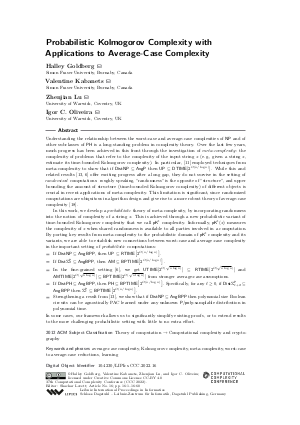@InProceedings{goldberg_et_al:LIPIcs.CCC.2022.16,
author = {Goldberg, Halley and Kabanets, Valentine and Lu, Zhenjian and Oliveira, Igor C.},
title = {{Probabilistic Kolmogorov Complexity with Applications to Average-Case Complexity}},
booktitle = {37th Computational Complexity Conference (CCC 2022)},
pages = {16:1--16:60},
series = {Leibniz International Proceedings in Informatics (LIPIcs)},
ISBN = {978-3-95977-241-9},
ISSN = {1868-8969},
year = {2022},
volume = {234},
editor = {Lovett, Shachar},
publisher = {Schloss Dagstuhl -- Leibniz-Zentrum f{\"u}r Informatik},
address = {Dagstuhl, Germany},
URL = {https://drops.dagstuhl.de/entities/document/10.4230/LIPIcs.CCC.2022.16},
URN = {urn:nbn:de:0030-drops-165785},
doi = {10.4230/LIPIcs.CCC.2022.16},
annote = {Keywords: average-case complexity, Kolmogorov complexity, meta-complexity, worst-case to average-case reductions, learning}
}

 Creative Commons Attribution 4.0 International license
Creative Commons Attribution 4.0 International license







